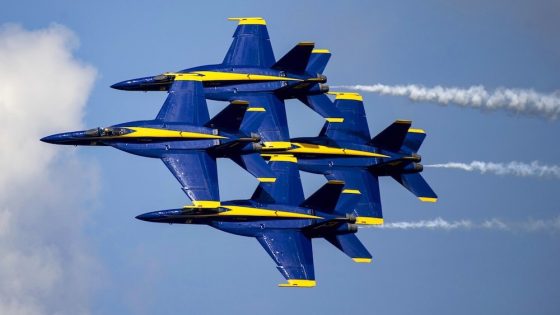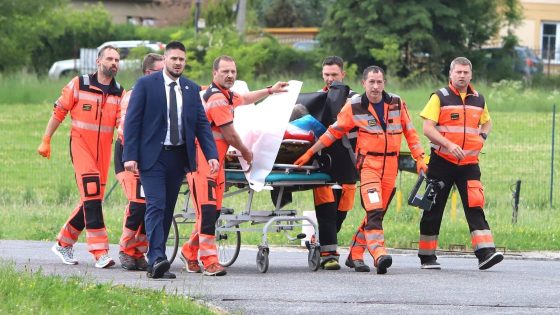Chronicling the eponymous Navy flight squadron across a season of demonstrations, “The Blue Angels” easily ranks near the top of the many Hollywood films to be considered “military propaganda” for their glowing depiction of the activities of U.S. men and women in uniform.
Whether or not that’s a good thing may come down to one’s feelings about the U.S. military. But in selecting for its subject an organization that performs a service that is itself public relations — and notably involves no battlefield operations — Paul Crowder’s Imax documentary feels both more honest than most in its intentions and more effective in highlighting that organization’s excellence.
Framed by the sun-up-to-sundown schedule maintained by the pilots themselves, “The Blue Angels” examines the precision, resilience and especially teamwork that goes into performing a series of dizzying, extremely dangerous aerial maneuvers. Less a celebration of the U.S. Navy’s Mavericks than its Top Guns, the film focuses on several pilots — in particular, Angels first-year flyers Chris “Cheese” Kapuschansky and Scott “Jamz” Goossens — as they learn the difficult choreography and rigorous standards maintained by the squadron.
Crowder ceremoniously drops the audience into the Angels’ world with a recitation of their creed, and then immediately shifts locations to a briefing room where Brian “Boss” Kesselring, the organization’s 2022 flight leader, uses piloting shorthand to sprint through a breakdown of the environmental conditions the team will face. It’s just the first day of preparation for the season, but the filmmaker means to mirror for the experience of those incoming pilots, creating a sense of disorientation and urgency as the audience gets its bearings in a collegial but intensely demanding environment. Subsequent interviews with Kesselring, shot in medium close-up as he looks directly at the camera, further establish his clear-eyed, compassionate authority, but they may force theatrical audiences to lean back a bit in their chairs. (Those catching the film on Prime Video after its weeklong run in theaters will likely feel less like Kesselring is right in their faces.)
Once Crowder follows the pilots into their cockpits, the aerial sequences become as demonstrative as they are breathtaking, exploring the granular complexity of flying four planes at 400 miles per hour 18 inches apart from one another in a perfect diamond shape. The first-person perspectives from each pilot manage to be both exhilarating and nerve-wracking, looking up at the looming silhouette of their teammate’s aircraft as they attempt to align the yellow paint on the two planes’ wings. In both voiceover and on-camera interviews, the pilots offer their perspectives as they learn the choreography, then watch and rewatch and dissect and discuss their performances in slow-motion footage, emphasizing every mistake in order to improve.
Eventually, the tour begins, giving Crowder an opportunity to detail the manpower and equipment involved in transporting the Angels to dozens of destinations across the country — from their unofficial hometown of Pensacola, Florida to the Hawaiian islands and back again. It’s during these sequences that the pilots discuss the more personal challenges of joining the Angels, starting with the 300 days per year they end up being away from their families, even when their spouses are also military personnel. Kesselring characterizes his time with the Angels as an opportunity to “give back,” but it’s clear that being a part of the elite group comes at a real cost to each of them.
Crowder further highlights that even without combat responsibilities, there are real risks for Angel pilots, referencing the 2016 death of Captain Jeff Kuss to trace the history of personnel losses sustained since the organization was established in 1946. The detour adds a degree of complexity to what is meant to be an informational, even celebratory look at the Angels, building a cumulative intensity to the final chapter of the film, in which Kesselring concludes his tenure as flight leader and selects his own replacement, an operational opportunity shared by few other divisions in the military. He also leads the charge in picking new additions to the team, one of whom, Amanda Lee, makes history as the Angels’ first female member.
In portraying what Kapuchansky and Goossens endure, and then what the new recruits go through during orientation (a G-force simulator knocks out both Lee and new flight leader Alexander Armatas), Crowder lends greater seriousness and substance to a military operation that is by design performative. The Blue Angels literally fly a victory lap for the U.S. Navy (one pilot playfully calls the demo “45 minutes of pure violence”), but their squadron also provides a window, undoubtedly safer than combat footage, into the extraordinary standards maintained by its pilots at every step of every operation. For viewers who haven’t attended one of the group’s events, Crowder’s film offers a uniquely intimate perspective on the maneuvers — including shots in slow motion, from angles civilians never see — while also spotlighting the men and women who bring them to life.
The disadvantage of a documentary like this is that it lacks the more dramatic stakes of a fictional narrative, leaving instead a glossy, promotional feel. Even so, military boosters will likely thrill at the skillful piloting and cheer the thoughtful, clean-cut men and women in the cockpit. Especially on the biggest screen possible, “The Blue Angels” not only offers an inside look at the best of the U.S. Navy’s best, but gives viewers a first-person seat for some truly great aerial maneuvers — and best of all, without having to leave the ground.
VIP+ Analysis: ‘Blue Angels’ Tests Imax’s New ‘Documentary Blockbuster’ Plan
Source Agencies



